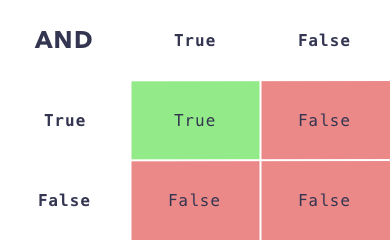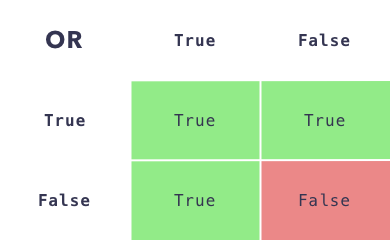Python's and and or keywords can be confusing for beginner programmers, but also for programmers coming from other programming languages. That's because in Python, these operators can behave differently than in other languages!
Traditionally, and and or are used to compare true and false values. We do this in English too:
- This is true when this and that are both true: "This man is a bachelor if he is both a man and unmarried".
- This is true when either this or that (or both) are true.
For simplicity, here's a diagram of how and works. If both conditions are true, the result is true. If either condition is false, the result is false.

or is somewhat opposite: the result is false only if both conditions are false. Otherwise, the result is true.

In Python, we would write and or or between the True and False keywords. Like this:
>>> True and True
True
>>> True and False
False
>>> True or False
True
>>> False or False
False
Boolean logic in Python
Python takes this logical evaluation one step further:
andreturns the first value if it evaluates to false, otherwise it returns the second value.orreturns the first value if it evaluates to true, otherwise it returns the second value.
And
Let's start with and and look back at the code we had above:
>>> False and True
False
>>> True and True
True
>>> True and False
False
In the first example, False and True, the first value is False. According to our truth table when any value is False, the result will always be False. Python knows this, so as soon as it encounters False, it returns that. It doesn't even check the second value!
For the second example, True and True, Python will look at both values. Although they are both the same, it is actually giving us the second True.
We can see this in the final example, True and False, where Python checks the first value and it is True, so it gives us the second value, False. Again, it doesn't need to check this value.
Or
>>> True or False
True
>>> False or True
True
>>> False or False
False
In the first example, True or False, Python starts by looking at the first value. It is True, so it returns that immediately. Looking back at the table above, if either of the values is True the result will always be True, so Python saves time by returning immediately after the first value.
In the second example, False or True, the first value is False. Python then returns the second value.
In the third example, the same thing happens. The first value is False, so Python returns the second value—also False.
It may seem weird that we're talking about returning the first or second value, but if we compare all this against the true/false tables earlier, you'll see they map exactly. Plus, Python can use this in other scenarios which don't involve True and False!
Using this without True and False
You can also use these operators on values other than Boolean values.
And
Remember, when using and Python returns the first value if it evaluates to False. So what about this?
>>> None and '35'
None
Should that give you an error?
In many programming languages it would, but in Python it gives you None. That's because in Python, None evaluates to False. We'll cover why in just a moment!
Here's a couple more examples:
>>> None and '35'
None
>>> x = []
>>> x and 12
[]
>>> 10 and 20
20
In these examples, None and [] evaluate to False, so the and operator returned them in both cases since they are the first value. 10 evaluates to True, so the and operator returned the second value.
Or
With or, the first value is returned if it evaluates to True. Look at this:
>>> None or '35'
'35'
Since None evaluates to False, the '35' is returned.
Here's a couple more examples:
>>> None or '35'
'35'
>>> x = []
>>> x or 12
12
>>> 10 or 20
10
Here, None and [] evaluate to False, so the or operator returned the second value in both cases. 10 evaluates to True, so the or operator returned the first value.
What are "Truthy" and "Falsy" values?
In Python, when a value evaluates to True we call it "Truthy". Similarly, when it evaluates to False we call it "Falsy".
Most values in Python are "Truthy". What that means is when you pass them to the bool() function, it returns True:
>>> bool(None)
False
>>> bool('35')
True
>>> bool(10)
True
>>> bool([])
False
>>> bool([1, 2, 3])
True
The values that are "Falsy" are:
- Empty strings, lists, tuples, dictionaries, and other empty iterables.
None0and other zero numbers (such as0.0).- All "Falsy" values can be seen in this link.
Recap
- The
orkeyword returns the value in front of it (the first value) if it is "Truthy". Otherwise it returns the second value. - The
andkeyword returns the first value if it is "Falsy", otherwise it returns the second value.


